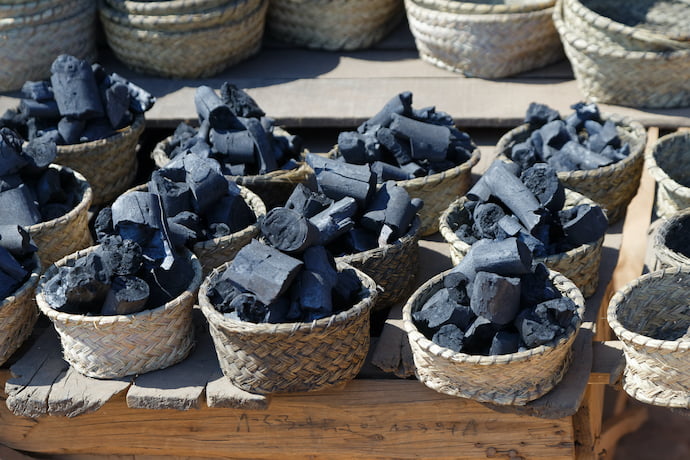Charcoal was used as early as 200,000 B.C., which makes it one of the first technological developments made by people. Charcoal is made when the wood is burned slowly without air. Charring removes most of the flavour-making chemicals and most of the water from the wood, leaving a carbon-rich fuel that burns hot, cleanly, and efficiently. Also, coal dust gives off a more focused flame. So, it makes sense that it’s still used by most grill masters around the world. But not every kind is the same – here are the main five for you to consider.
1. Wood Charcoal
Charcoal made from wood is simply known as wood charcoal. It’s most often used for cooking and business purposes. This form is better than charcoal made from other materials in a number of ways, such as the fact that the heat of combustion can last longer, that it gives food grilled with charcoal a unique flavour, and that it can be used to power steam-powered machinery in the industry. It’s versatile and can be used as a heat source or in the kitchen. Colourants made from wood charcoal are also popular among artists.

2. White Charcoal
Also known as hardwood Binchotan and the purest form available and it’s exceptional for the long burning. The name comes from Japanese meaning charcoal. This high-carbon oak charcoal is highly sought after by chefs all over the world. Its high carbon concentration renders it utterly devoid of aroma.
The food’s inherent flavours are enhanced when cooked with it. This is also unique about Japanese charcoal: It gives off a steady, high, and clean heat. White charcoal comes from carefully chosen hardwoods and is made in a more complicated way than regular wood charcoal or coconut charcoal. It is strong, white, and doesn’t have any dust.
The Binchotan charcoal has been used for centuries in Japan and is known as the best ever made for cooking healthy food for a balanced lifestyle. It’s also great for purifying water, so you don’t have to buy bottled water when you need a clean water supply. Lastly, it works well in beauty products like facial soaps.
3. Chunky Charcoal
This is the original charcoal, which is sometimes called “charwood” or natural lump charcoal. Trees or logs are burned in a kiln, a sealed cave, or even underground to make this charcoal. Lump charcoal, on the other hand, is made entirely of wood and doesn’t have any glues or petrochemicals to make it burn faster. Briquettes of charcoal burn hot, clean, and pure. If you add unlit charcoal to a lump charcoal fire, you won’t get the harsh smoke that comes from newly lit briquettes, much like the odourless and smokeless Binchotan option.

Natural lump charcoal, on the other hand, burns unevenly, getting hotter at the beginning and cooler at the end. It also burns out faster than charcoal briquettes. When you grill with lump charcoal, you’ll have to add more fuel to the grill more often, usually every 30 to 40 minutes. Lump charcoal comes in square or rectangular blocks with straight edges. It is not made from logs. If you need lump charcoal, you can get it from Elvatara Coal.
4. Charcoal Briquettes
They should “boil” at a temperature of at least 600 degrees Fahrenheit for at least one hour. Traditional briquettes are made of wood scraps, sawdust, coal dust, borax, and a petroleum binder, so it’s not surprising that when you first light them they give off smoke that tastes bitter. The briquettes that make up instant-ignition charcoal are soaked in lighter fluid.
The harsh smoke goes away when the charcoal turns orange and ashes over, but you’re still grilling over borax, coal dust, and petroleum binders. Even though the petroleum-based accelerants in instant-light charcoal should burn out, they can leave an oily taste if they are not completely lit. Natural briquettes, which are made from wood scraps and glues made from starch, are meant to solve these problems.

5. Coconut Shell Charcoal
Charcoal made from coconut shells is what this type is made of. Charcoal made from coconut shells is a great fuel because it gives off more heat and has more energy (7,340 calories) than wood charcoal, for example. Charcoal from coconut shells is often used for things like this, in addition to being used as fuel. Since old coconuts are denser and have less water than young coconuts, they should be used to make coconut shell charcoal.
Elvatara Indojaya is one of the best places in Indonesia to get it. Elvatara sends charcoal made from coconut shells to many countries, including China, Korea, Europe, and the Arab world. So, whichever type you choose from the above-mentioned, the one takeaway you should have is that charcoal can be used to create a flame that is hotter and lasts longer without adding more fuel, and you surely get more flavourful food than grilling with wood or gas.



